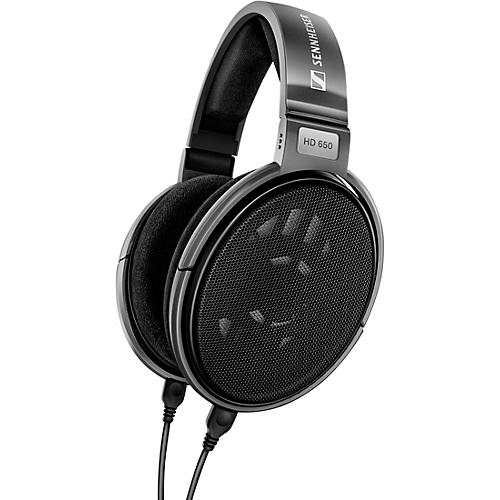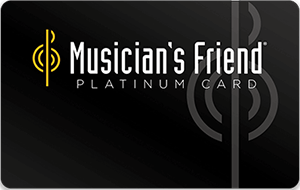Why Shop With Us?
Free Shipping
Free Standard Ground shipping (48 contiguous states, some overweight and Used/Vintage items excluded).
Orders placed before 3 p.m. ET usually ship the same business day.
Learn More2-Year Free Warranty on Guitars
Every guitar or bass you purchase from Musician's Friend (electric or acoustic, New or Open Box) includes two years of protection from manufacturer defects.
Contact Us for DetailsWe're Here for You
Our Gear Advisers are available to guide you through your entire shopping experience. Call or Chat for expert advice and to hear the latest deals.
Contact UsContact Us
Hablamos Español
866.226.2919
Hours:
MON - FRI 6 AM – 7 PM PT
SAT 7 AM – 6 PM PT
SUN 8 AM – 5 PM PT











Sennheiser HD 650 Open-Air Pro Headphones
true true- Free Shipping
- Top Rated
- Top Seller
- Flexible Financing
Gold Coverage Protection
Protect your gear
HD 650 Open-Air Pro Headphones Specifications:
- Nominal impedance 300 Ohm
- Contact pressure ca. 2,5 N
- Weight w/o cable ca. 260g
- Jack plug 6,3/3,5 mm stereo
- Transducer principle (Headphones) open, dynamic
- Ear coupling circumaural
- Cable length 3 m
- Frequency response (headphones) 10.....39500 Hz
- Sound pressure level (SPL) 103 dB (1 Vrms)
- THD, total harmonic distortion 0,05 %
- Glossary
- Nominal impedance
- See impedance.
- Contact pressure
- The wearing comfort of a set of headphones is determined not only by its weight but also by the force with which the earpieces are pressed onto the ears. This force is given in newtons (N), whereby 1 N corresponds to the compressive force which a mass of about 100 g exerts on a solid surface. The DIN Standard 45500 Part 10 limits the maximum permissible contact force to 5 N. Values of between 1.3 and 4 N are common, although lower values apply for open headphones. Higher values can be found in the case of closed headphones. Here, a higher contact pressure is required in order to achieve sufficient sealing, which is important for the reproduction of low frequencies.
- Weight w/o cable
- Jack plug
- A common audio connector in consumer electronics and music industry. Available in various diameters; in the hi-fi segment, 1/8" and 1/4" are widely used. Poles range from one to four. (Examples: headphone jack or jack of an electric guitar).
- Transducer principle (Headphones)
- Ear coupling
- A distinction is made between headphones which are worn on the external ear (supra-aural) and those which surround the ear (circumaural). Open headphones have foam ear pads that rest on the ears or ring pads that surround the ears. Closed headphones, on the other hand, nearly always have circumaural ear pads.
- Cable length
- The cable length is usually measured between the anti-kink sleeves of the cable (cable length without connectors).
- Frequency response (headphones)
- The frequency response of a pair of headphones is given within limits defined by the manufacturer.
- Sound pressure level (SPL)
- Due to the impractical numerical values, the sound pressure is usually given as the logarithmic value of the sound pressure level according to the equation: dB SPL = 20 x log (po / 0.00002 Pa). The abbreviation SPL (sound pressure level) is added in order to make a clear distinction from other uses of dB. The reference sound pressure, which is at the same time the threshold of hearing, is then 0 dB SPL. The threshold of pain is 140 dB SPL. A difference in the sound pressure level of 1 dB is just about perceptible, while a doubling of the sound pressure corresponds to 6 dB and a doubling of the volume corresponds to a rise of 10 dB.
- THD, total harmonic distortion
- Total harmonic distortion is a measure of non-linear harmonic distortion and is given in %. Non-linear harmonic distortions are signals which were not present in the original before the signal was converted by the headphones. These unwanted signals are caused by the diaphragm, whose movements do not precisely move in time with the electric signals that cause it to move. Unfortunately, this is a feature of all electroacoustic transducers. Although it cannot be completely eliminated, suitable steps can be taken to minimise it. However, the user is not interested in why this distortion takes place but in how great the level of distortion must be for it to become perceptible. According to the findings of several research projects, a total harmonic distortion of 1% in the frequency range of 100 to 2000 Hz is imperceptible. Below 100 Hz, the perceptibility threshold lies at 10%
Questions & Answers
Do you have questions about this product?
- Free Standard Ground shipping (48 contiguous states, some overweight and Used/Vintage items excluded).
- Orders placed before 3 p.m. ET usually ship the same business day.
Every guitar or bass you purchase from Musician's Friend (electric or acoustic, New or Open Box) includes two years of protection from manufacturer defects.
Our Gear Advisers are available to guide you through your entire shopping experience. Call or Chat for expert advice and to hear the latest deals.













































































































































